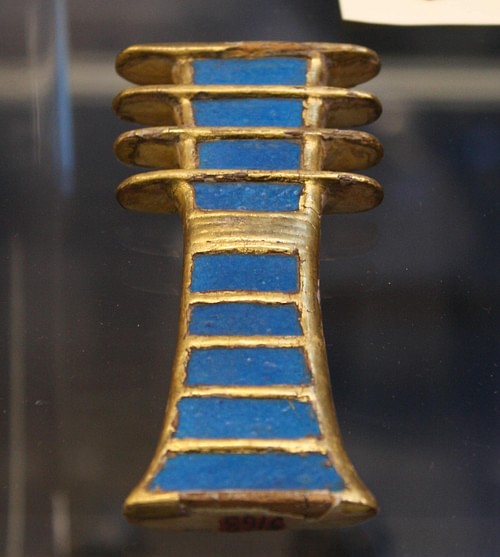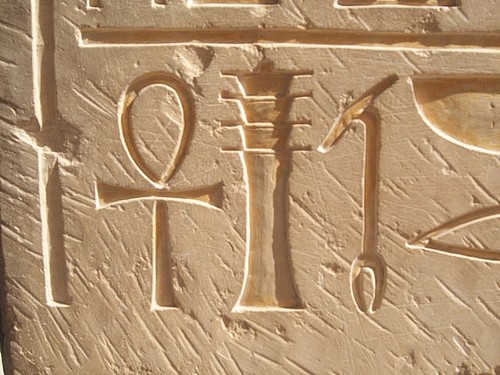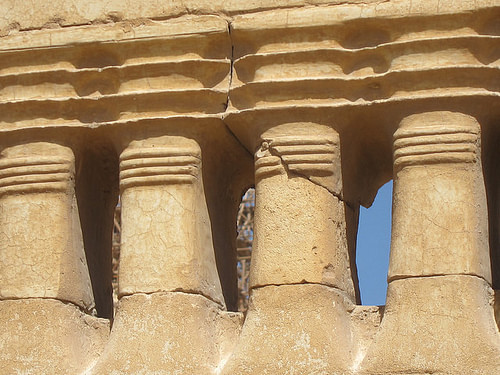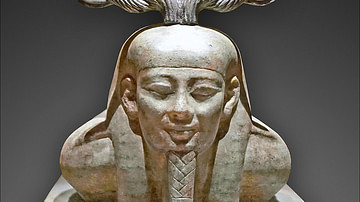
The djed is an ancient Egyptian symbol for stability which features prominently in Egyptian art and architecture throughout the country's history. `Stability' should be understood to mean not only a firm footing but immutability and permanance. The symbol is a column with a broad base which narrows as it rises to a capital and is crossed by four parallel lines. The column and the lines are sometimes brightly painted and other times monochrome. The djed first appears in the Predynastic Period in Egypt (c. 6000-3150 BCE) and continues through the Ptolemaic Dynasty (323-30 BCE), the last dynasty to rule Egypt before it became a province of the Roman Empire.
The djed is often overlooked in Egyptian art, and especially in architecture, simply because it is so ubiquitous; the djed is featured on pillars, tomb walls, architraves (the main beam which rests on pillars), palace walls, sheets of painted papyrus, and especially sarcophagi. Once one is aware of the djed and its importance to ancient Egyptian culture it is impossible to miss. It is a potent symbol associated with the god Osiris and his return from the dead. The symbol has been interpreted to represent different objects such as the god Osiris' backbone, the tamarisk tree which enclosed the god, four pillars rising one behind another, and a fertility pole raised at festivals. `Stability', however, seems to have been its prime meaning and the one which the ancient Egyptians attached the greatest importance to.
Meaning & Origins
The precise origin of the djed is unknown but it was associated with the god Ptah, an early creator god in the Predynastic Period whose attributes were later assumed by the deities Atum and Osiris. According to historian Clare Gibson, the djed was an early phonogram which could also act as a pictogram or ideogram. A phonogram is a symbol representing a sound and a pictogram a symbol for a specific word or phrase while an ideogram is a symbol of a thing itself without reference to words or sounds (such as numerals where one recognizes the symbol 10 as representing a certain quantity). The djed symbolized the spoken word-concept for stability, was the written word for stability, and stood for the concept itself.
In the Predynastic Period it may have originally been a representation of a fertility pole upon which sheaves of grain were suspended at festivals. This pole may have been a feature of early fertility rituals which eventually came to be associated with the god who made the land fertile. The god Ptah carried a sceptre which combined the djed and the Ankh (symbol of life) and is referenced as "The Noble Djed" in ancient inscriptions. The Djed Pillar Festival was held annually at which an actual djed pillar was built and raised by the local priesthood on the first day of the harvest season. Raising the pillar may have originally symbolized the grains rising from the earth but, in time, came to represent the god Osiris returning from the dead.
With the rise of the cult of Osiris, the djed came to be firmly associated with him and, especially, with the tree of Byblos which enclosed him and the pillar made from that tree. The djed also symbolized the backbone of Osiris in that, just as Osiris rose from the dead, the deceased would rise from their body after death. In the same way that the human backbone allowed one to sit up and stand and walk, the spiritual image of Osiris' backbone would encourage the soul to rise up from the body and move toward the afterlife. The myth of Osiris was one of the most popular in ancient Egypt, especially in the period of the New Kingdom (1570-1069 BCE). The story details the death of the god, his ressurection by his wife Isis, and descent to the underworld to reign as Lord of the Dead.
The Myth of Osiris
In the beginning of time, shortly after creation, the gods Osiris, Isis, Set, Nepthys, and Horus were born of the union between Geb (earth) and Nut (sky). Osiris, as the eldest, was given reign of the earth and took his sister Isis as his wife and queen. Set grew jealous of Osiris' success and trapped him in a coffin which he then threw into the Nile River. The coffin floated to the Phoenician city of Byblos where it became lodged in a tamarisk tree by the shore. The tree quickly grew around and enclosed the coffin within it. The king and queen of Byblos noticed the tree and that it gave forth a sweet scent and so had it cut down and brought to their palace to decorate the court as a central pillar.
Isis, in the meantime, had gone searching for her missing husband and finally arrived at the court of Byblos. Disguised as an older woman, she ingratiated herself to the royal family by teaching the handmaidens how to plait their hair and became nursemaid to the young princes. Isis was particularly fond of the younger child, Dictys, and tried to make him immortal by burning away his mortal part in a flame. When the queen found her doing this one night she became upset and Isis threw off her disguise to reveal herself as a goddess. The royal couple begged her mercy for their affrontery and promised her anything she wanted; Isis claimed the tree which held her husband.
She freed Osiris' body from the tree and brought him back to Egypt to revive him but, while she was out gathering the necessary herbs, Set found the body, cut it into pieces, and scattered it across the land. When Isis found her husband had been dismembered she instantly set about collecting his remains with the help of her sister Nepthys. They found all his body parts, except for his penis which had been eaten by a fish, and he was brought back to life. Isis transformed herself into a kite and summoned the seed from Osiris' body by flying around him, drawing the seed into herself and becoming pregnant with a son, Horus. Osiris, since he was not complete, could no longer rule the living and descended to the underworld as Lord of the Dead. Horus grew to maturity and then challenged Set for rule, defeating him and restoring order to the land. The myth illustrated the importance of ma'at (harmony) and the triumph of order over chaos.
The Djed & Osiris
This best known version of the myth (which comes from the Greek writer Plutarch, 45-120 CE) places the tamarisk tree at Byblos but other versions say the tree was by the shores of the city of Djedu in Syria. This has led some scholars to assert that Osiris was originally a Syrian fertility god who was introduced to Egypt through trade. According to this theory, the djed was their cult symbol which was based on the practice of decorating a pillar to resemble a tree and draping it with icons representing fertility and abundant harvest. This theory has some merit, primarily due to the name of the Syrian city lending itself to the symbol, but falters in claiming validity based on the scarcity of trees in Egypt and their abundance in Syria.

Whatever abundance of forestation Syria may or may not have enjoyed, trees featured prominently in Egyptian literature as special blessings from the gods and even their homes. Osiris may have originally been a Syrian deity but one cannot base this claim on a scarcity of trees in Egypt. Osiris' name first appears in the Fifth Dynasty of Egypt (2498-2345 BCE) even though images of him pre-date this period and his origins are obscure. By the time of the New Kingdom, however, he was among the most popular and important gods of Egypt and the djed symbol was linked to his story. Scholar Geraldine Pinch comments on this, writing:
By the New Kingdom, the djed was closely associated with the mythology of Osiris. The taboo subject of the murder of Osiris could be alluded to by saying that Set had "laid the djed on its side". Scenes in temples or royal tombs show the god Horus (or the king playing the role of Horus) raising the djed column to help his father Osiris to rise from the dead (128).
The Osiris myth, with its emphasis on resurrection, immortality, and order from chaos, expressed some of the most highly valued concepts in Egyptian culture and Osiris became one of the most often invoked gods. His wife, Isis, rose to even greater prominence to eventually become the only deity in Egypt worshipped by everyone regardless of their location or duty to other gods. Isis was associated with the symbol of the tiet (also tjet, the `knot') representing fertility and was often paired with the djed, especially on Egyptian coffins. Scholar Clare Gibson comments on this pairing, writing:
It is particularly significant that the djed and the tiet are given such prominence, for these symbols respectively represented Osiris and Isis, or the masculine and feminine principles (and it is probably no coincidence that one is phallic and the other, uterine in shape), and together thus the innate potential to bring new life into being (159).
Osiris, though no longer ruler of the world, had given life to the people and, through his son, brought harmony to the land. In his role as Lord of the Dead, Osiris was the just judge who presided over the fate of the soul in the Hall of Truth. It is hardly surprising, then, that his symbol should be found on the walls of tombs, in the Pyramid Texts, and on coffins. The Egyptians believed that their earthly journey was only one aspect of an eternal voyage and death was simply another realm to be traveled. The djed symbol, like the Pyramid Texts themselves, would have been inscribed where the soul could see it in order to help free the eternal aspect of the individual from the physical body after death.
The Djed in Art & Architecture
As noted above, there are so many instances of the djed featured in the art works and building projects of the Egyptians it is impossible to overlook the symbol once one is aware of it. A notable use of the Djed in the Early Dynastic Period (c.3150-2613) is the temple complex of the Step Pyramid of Djoser at Saqqara. The pillars of the interior of Temple T, in the Heb Sed Court, are decorated with djed symbols. The djed is also represented in a very interesting fashion at the South Tomb of the complex where a series of cobras rise in stone from the facade. The spaces in between these cobras are djed-shaped.
Raising the djed pillar was an important part of the festival known as the Heb Sed which was observed to restore power to the king. Geraldine Pinch notes how, at this festival, "the raising of the djed was preceeded by a mock combat between people representing the opposing forces of order and chaos" (128). Once order had been restored, the djed pillar was raised as a symbol of triumph and stability. The king would be renewed through his association with Osiris who returned from death to life. Temple T's djed pillars and the other djed symbols in the Saqqara complex invoked not only Osiris and his resurrection but represented stability in that they were carefully placed to look like pillars holding up the sky. There are many different sites throughout Egypt where one sees djed symbols repeated across the lintels and architrives of buldings and, if one does not recognize the djed, these seem to be simple ornamentation; if one does, however, the djed symbols are clearly pillars supporting the canopy of the sky above.
In the Old Kingdom the djed is featured prominently on tombs as it continues to be in the New Kingdom. The Book of the Dead is illustrated with so many djed symbols that they sometimes blend into a kind of wallpaper behind the images of the soul ascending and the attendant gods. The New Kingdom tomb of the scribe Ani, dated to c. 1250 BCE, is inscribed with a page from the Book of the Dead customized to speak directly to Ani's soul. As with all such tomb inscriptions, the purpose was to direct the soul toward the afterlife and assist in leaving the body and the things of the earth behind. Ani's tomb shows his soul leaving his wife, his life, and his body behind to travel toward Osiris in the Hall of Truth. Gibson comments on this, writing:
The vignettes that illustrate the passages of text reproduced here are all imbued with profound significance regarding what the ancient Egyptians devoutly hoped would occur after their death, with the scenarios shown invoking the aid and protection of the gods Osiris, Anubis, and Nepthys, and giving prominent positions to such amuletic symbols as the djed pillar and the lotus and papyrus plants (173).
The djed pillar not only symbolized stability in life and after death but also the enduring presence of the gods in one's life. The symbol assured the ancient Egyptians that the gods were with them every step of their journey through their earthly travels and would continue with them after death. The djed symbol promised human beings that, like Osiris, they would rise from death to life and continue on to live eternally in the Field of Reeds. The Egyptian afterlife was a mirror-image of one's life on earth but eternally blissful without loss, disappointment, or death. The immutability of the soul and the promise of this eternal life was represented by the djed. The symbol appears so regularly throughout Egypt's history because it reminded the people of the true nature of life, that death was not the end, and that the gods were always near.







